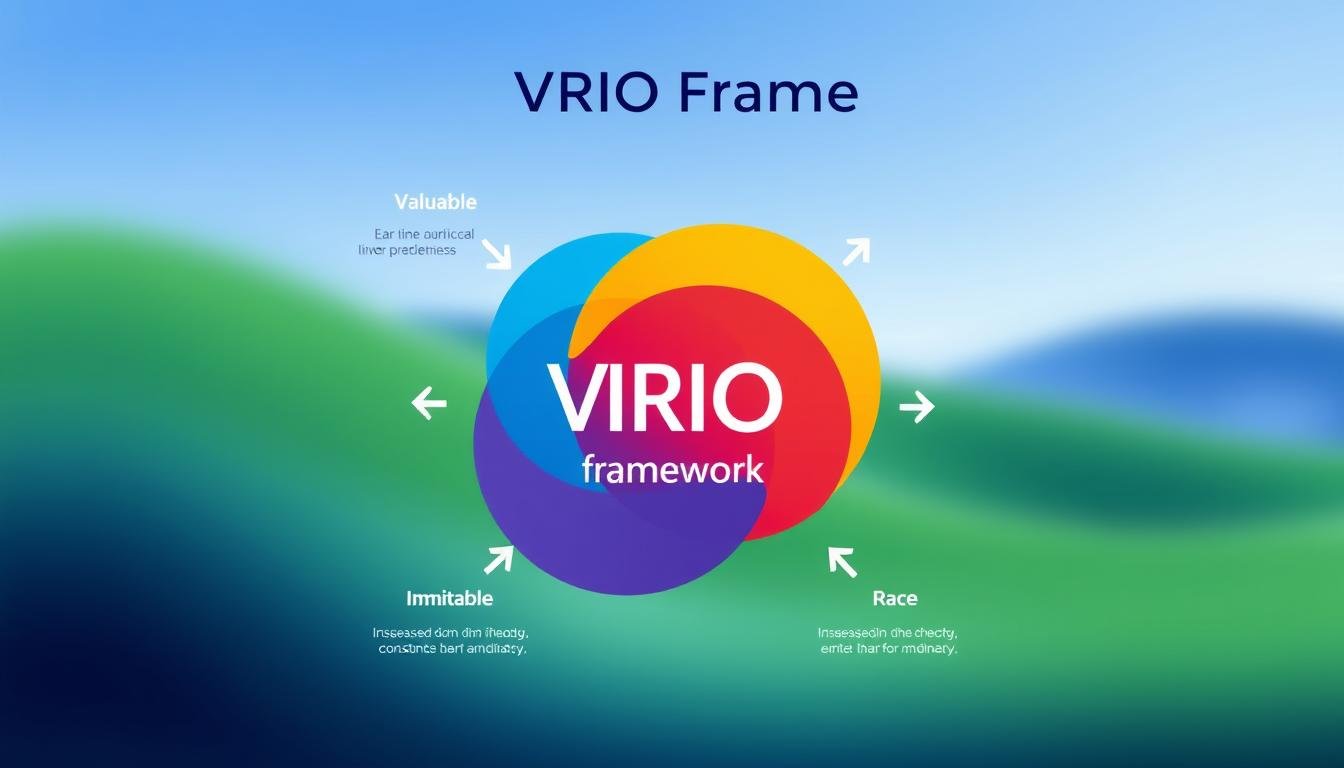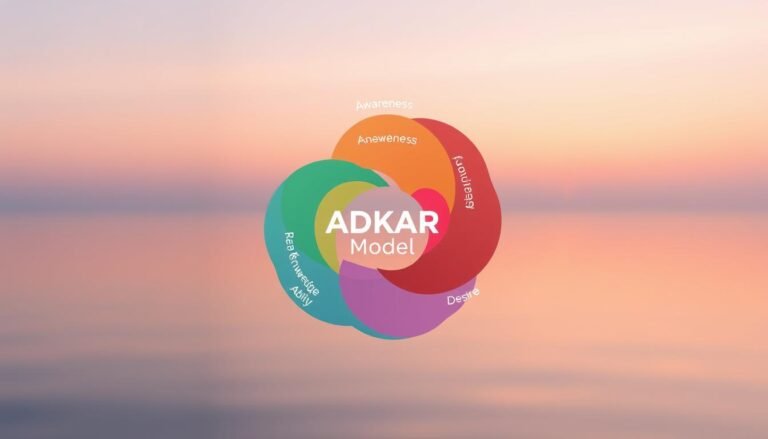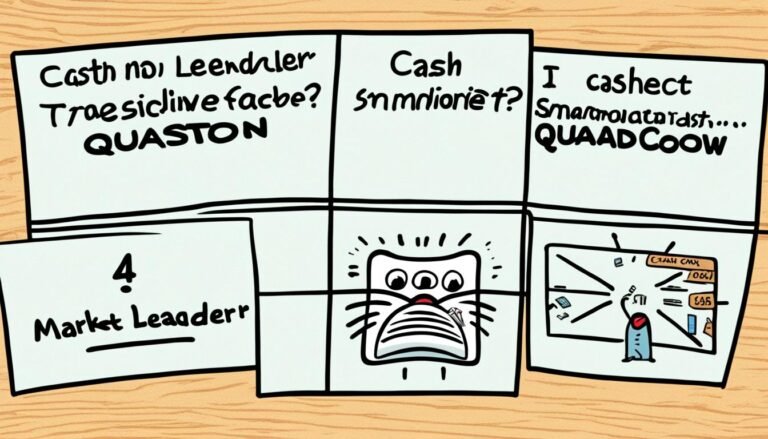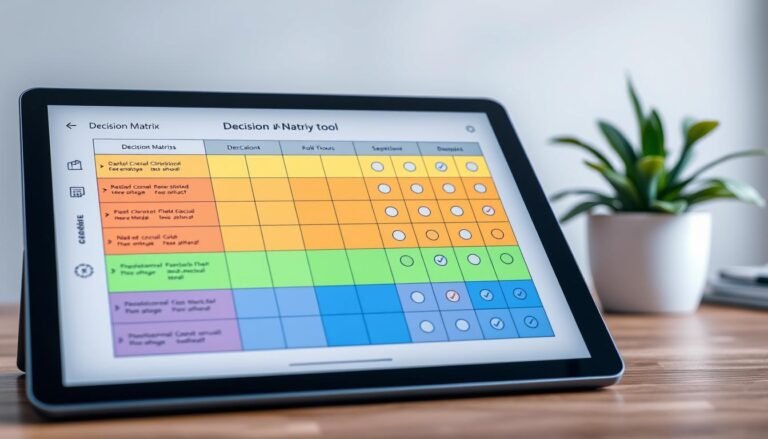VRIO Framework: Analyzing Competitive Advantage
What if the secret to doing well in a crowded market isn’t about beating others? It’s about knowing and using what’s inside your company. This idea is at the heart of the VRIO Framework. It’s a tool created by Jay Barney in 1991 to help businesses find their unique strengths.
By looking at resources in a specific way, the VRIO analysis shows what makes a company stand out. It answers four key questions to help achieve a lasting edge. Are you ready to see what makes your company special?
Key Takeaways
- The VRIO framework evaluates resources based on Value, Rarity, Inimitability, and Organization.
- It assists organizations in determining their competitive advantages and core competencies.
- Insights from VRIO analysis guide strategic decision-making for long-term sustainability.
- Valuable and rare resources that are difficult to imitate lead to sustained competitive advantage.
- Organizational structure plays a critical role in leveraging resources effectively.
- Conducting a thorough VRIO analysis can be resource-intensive yet rewarding for strategic planning.
Introduction to the VRIO Framework
The VRIO framework is key for making a strong business plan. It helps find out if a company can keep a lead in the market. About half of companies find it hard to see what makes them stand out. This shows why the VRIO model is so important for strategy.
What Does VRIO Stand For?
VRIO means Value, Rarity, Imitability, and Organization. Each part is important for seeing if a company’s strengths can give it an edge. To use the VRIO framework well, companies need to answer four big questions:
- Value: Do these strengths meet customer needs and provide value?
- Rarity: Are these strengths unique within the competitive set?
- Imitability: How difficult is it for competitors to replicate these strengths?
- Organization: Is the organization structured to exploit its strengths effectively?
Importance of Sustainable Competitive Advantages
Sustainable competitive advantages are what make a company better than its rivals. The VRIO framework helps spot these key resources. For example, Google uses data to improve hiring and keep employees. This shows how hard it is for others to copy such strategies.
Creating a growth plan means making sure these advantages are valuable, rare, and hard to copy. This is key for long-term success in the market.
To use this framework, companies must first identify their core strengths. It’s easy to miss strengths that don’t matter to customers or confuse common assets with real advantages. By applying the VRIO framework, companies can build on their unique strengths and make a lasting impact in their fields.
| Component | Definition | Key Question |
|---|---|---|
| Value | Strengths that fulfill customer needs | Does it add value? |
| Rarity | Unique strengths not commonly found in competitors | Is it rare? |
| Imitability | Difficulty for competitors to mimic strengths | Is it hard to imitate? |
| Organization | Structure to exploit strengths effectively | Is the organization well-positioned? |
Understanding the Components of the VRIO Framework
The VRIO framework is key in strategic management. It helps companies check their resources and strengths. By looking at the VRIO framework, businesses can spot what makes them stand out and keep doing well.
Value: Assessing Customer Benefit and Organizational Alignment
Valuable resources help customers and match the company’s goals. Think about how a resource solves customer problems or makes things better. Tools like value chain analysis and SWOT analysis help see the customer benefit clearly. Things like a strong brand or special skills are often key to a company’s value.
Rarity: Uniqueness in Your Industry
Rarity means resources that are hard for others to get. To see if something is rare, look at the market and what others have. Companies should think about both current rivals and new ones to see if their resources are rare. Being rare can give a big edge in competition.
Imitability: Barriers to Competitor Replication
For resources to keep giving an edge, they must be hard to copy. Things that make it hard for others to imitate can include history, social factors, and protected ideas. Knowing these barriers to imitation helps see what competitors can’t easily copy, keeping the company ahead.
Organization: Structuring for Competitive Advantage
The last part, organization, shows how a company’s setup is key to using resources well. This means looking at how management, rewards, and alignment work together. Companies need to be set up to use the benefits from the first three parts of the VRIO framework for long-term success.
Applying the VRIO Framework: A Step-by-Step Guide
Using the VRIO framework helps companies understand their strengths and what they can do well. Each step is key to finding what makes them stand out and use those strengths for long-term success.
Identifying Key Resources and Capabilities
First, companies need to spot the resources that give them an edge. These can be things you can touch, like money and buildings, or things you can’t, like skills and brand names. Key resources include:
- Financial resources: Cash and properties that help keep the company stable.
- Human resources: The skills and knowledge employees bring, crucial for getting things done.
- Material resources: Tools and buildings that help make and deliver products or services.
- Non-material resources: Things like patents and brand names that set them apart in the market.
Evaluating Resources Through VRIO Criteria
After finding the key resources, it’s time to check them against the VRIO criteria. This means looking at:
- Value: Is the resource really helping customers in some special way?
- Rarity: Is this resource something other companies can’t easily get or match?
- Imitability: How hard would it be for others to copy this resource?
- Organization: Does the company have the right setup to use these valuable resources well?
Prioritizing Strategic Investments
It’s important to focus on resources that score high on all VRIO criteria. These should be the ones you invest in to keep your edge. For example, Google’s search algorithm is a great example of how these criteria work together for success. Regularly reviewing your resources helps you stay on top of changes in your field.
| Resource Type | Attributes | Examples |
|---|---|---|
| Financial Resources | Cash, investments | Capital for expansion |
| Human Resources | Skills, knowledge | Employee expertise |
| Material Resources | Equipment, facilities | Manufacturing tools |
| Non-Material Resources | Patents, brand | Intellectual property |
VRIO Framework in Business Strategy: Benefits and Limitations
The VRIO framework is key in business strategy, offering big ups and downs. It focuses on resources that are valuable, rare, and hard to copy. Knowing the good and bad of the VRIO framework helps make better decisions and gain a lasting edge in the market.
Benefits: Strategic Clarity and Long-Term Focus
The main benefits of the VRIO framework are:
- Strategic Clarity: It helps companies know their strengths and set a clear direction.
- Long-Term Focus: It looks at resources for their lasting value, pushing for investments that keep a company ahead.
- Effective Resource Allocation: It lets companies focus on resources that are truly valuable, making better use of their money.
Limitations: Internal Focus and Dynamic Environments
But, the VRIO framework has its downsides:
- Internal Focus: It mainly looks at what’s inside the company, missing out on outside factors that shape the market.
- Dynamic Environments: Fast changes in the industry can make resources less useful over time. This makes it hard to stay ahead.
- Complementary Frameworks: Using only the VRIO framework might limit a company’s view of the market.
Understanding both the limitations of VRIO and its benefits helps companies use it well. This way, they can adapt to changes in the market.
Conclusion
The VRIO framework is key to understanding a company’s strengths by looking at four main parts: Value, Rarity, Imitability, and Organization. It helps companies spot what makes them stand out and plan for growth. This way, they can use their strengths well and adjust to market changes.
This framework also helps in making better strategies by focusing on what’s inside the company. It goes deeper than simple analyses like SWOT or PESTLE. By making sure resources are valuable, rare, hard to copy, and well managed, companies strengthen their position. They also make it harder for others to enter the market.
Using the VRIO model well helps companies deal with tough market challenges and plan for the future. It gives businesses the tools to boost their strengths and make smart choices in a fast-changing world.
Source Links
- VRIO Framework Overview: Analysis, Template & Examples
- VRIO Analysis
- Unlock Competitive Edge with VRIO Analysis: A Strategic Guide
- What is VRIO? VRIO Framework Explained in 4 Steps
- VRIO Framework Explained – SM Insight
- What is the VRIO framework? | i-nexus
- The VRIO Framework: A Tool to Effectively Evaluate Your Strategy | Lucidity
- How to Use the VRIO Framework to Set Your Product Apart
- How to Use VRIO Framework? The Four Steps
- VRIO Framework: What it is, Breakdown, Benefits & Limitations
- VRIO Framework Advantages and Limitations
- VRIO Framework: What it is and How to Use it Effectively
- VRIO Framework Explained: Evaluating Business Uniqueness Template
- The VRIO Framework (What it is and How to Use it)







